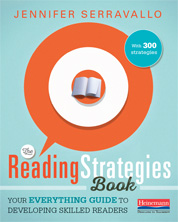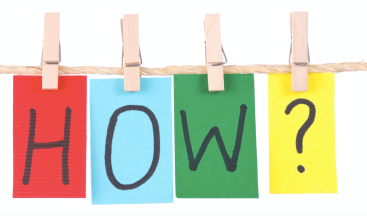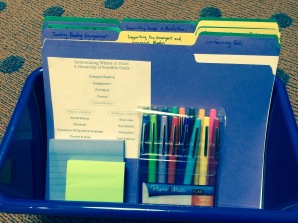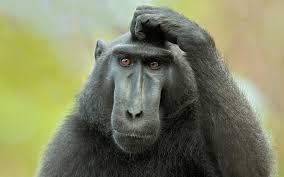 Every once in a very long while, a professional book comes along that generates genuine excitement from all who hold it. It just may be that it happens so infrequently that in my first 15 years of teaching, I had yet to experience this phenomenon. This year is different. This year is exciting. This year, Jennifer Serravallo’s The Reading Strategies Book: Your Everything Guide to Developing Skilled Readers has penetrated our school and our teaching.
Every once in a very long while, a professional book comes along that generates genuine excitement from all who hold it. It just may be that it happens so infrequently that in my first 15 years of teaching, I had yet to experience this phenomenon. This year is different. This year is exciting. This year, Jennifer Serravallo’s The Reading Strategies Book: Your Everything Guide to Developing Skilled Readers has penetrated our school and our teaching.
Number 6 on The New York Times Education Best Seller List, this book is jam-packed with actionable and intentional teaching moves that one can use with minimal preparation. Jen organized the book into 13 chapters. Each chapter is a specific goal. They range from Goal 1: “Supporting Pre-Emergent and Emergent Readers” to Goal 7: “Supporting Comprehension in Fiction: Understanding Themes and Ideas”. Within each chapter / goal lies a series of strategies that you could teach children who need work in that particular area. This series of strategies operates almost like a menu. You can choose the strategies that seem most relevant for the particular child(ren) with whom you are working. The strategies are described on a single page and include a description of the strategy, some prompts you might use to support children, examples of visual aids or children’s work, and a “Who is this for?” tab that includes appropriate text levels, genres / text types, and the skills that are addressed. Jen offers enough information so that you can begin to imagine how a particular strategy lesson might be taught, but not so much that you feel inclined to follow a script and use someone else’s words. She inspires us to think of these strategies in the context of our own students, making the lessons our own. (For more on the beauty and practicality of this book’s content and organization, check out Betsy Hubbard’s post on the Two Writing Teacher’s blog here and Kristi and Marjorie’s post on Chartchums here. You can also hear Jen herself describing how to use this book in this video.)
I work as a literacy coach at a pre-k – fourth grade independent school in New York City. We have a lot of autonomy in our school when it comes to reading instruction. As such, it can be challenging to know just how to bring colleagues together around reading curriculum, instruction, and learning goals. Jenn’s book proved to be a powerful vehicle.

How did I introduce the book to my colleagues?
The classroom teachers and I meet in grade level teams once a month for a 60 minute coaching meeting (professional development). I used several of our coaching meetings this fall (as well as some optional, drop-in meeting time) to focus on models of small group and individualized teaching: guided reading, strategy lessons, and one – one conferences. It is rare that someone would object to the benefits of small group or one-on-one instruction, but it is common for teachers to feel unsure of how to plan for and use that time effectively. The Reading Strategies Book has responded to this precise issue. I showed my colleagues how this book supports me in planning for both strategy lessons and one – one conferences. After demonstrating the planning, I taught the lessons in many classrooms. When Donna, the administrative assistant in our school, came knocking on my door to ask why everyone was suddenly requesting so many post-its and folders, I knew were hooked.
It went something like this:

What if… you had a small group bin in which you had materials (post its, pens, conferring note-taking sheets, etc.) and resources (possible teaching points, visual aids / mini-charts, “leave behinds” for children, mentor texts, etc.) all organized and ready for you to use during reading workshop?
What if… the resources in your small group bin were organized by reading goal? and you had a folder for each reading goal? and inside these folders were possible strategy lessons and possible teaching points for one – one conferences?
What if… The Reading Strategies Book gave us the language, ideas, and structure to do this work?
***
I demonstrated how one could take the words and ideas from the Reading Strategies Book and easily transplant them into a strategy lesson plan (see visuals below). While generating the lesson plan, I also demonstrated how I could use the book as a resource for generating visual aids and leave behinds (basically little post its or mini-charts that the child(ren) can keep as a reminder of the strategy he/she is working on). Finally, I demonstrated the lessons in the classroom with actual children.
We started with… the Hierarchy of Possible Goals that Jen introduces early on in her book. We thought of children in our classrooms and honed in on specific goals. Then, we dug into the table of contents for a particular goal and chose some lessons that looked interesting and read them.
We chose a strategy. We imagined teaching it in our rooms with particular groupings of children and planned the lesson, using a modified version of a strategy lesson planning template adapted from a workshop I attended at the Teacher’s College Reading and Writing Project.
and then we taught the lesson!
So, now what?
I see so much potential for how we can use the contents and ideas in The Reading Strategies Book, but what I love the most about this book is that because it is so accessible and practical, the potential now lies in all of our hands. I can surely continue to support colleagues in finding time and space to explore and try the strategy lesson ideas we have in this book, but the ideas in this book are also finding their way into classrooms and the minds of teachers organically and on their own.
Thank you Jennifer Serravallo! Your book speaks to us and is moving our thinking, and most significantly, our practice!







